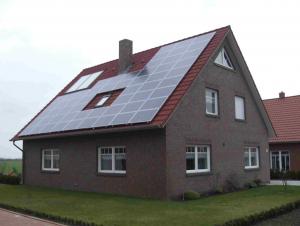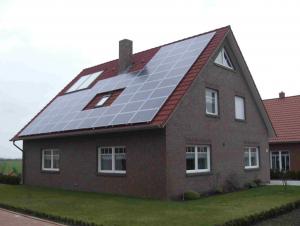MPPT Solar Charger Controller 20A/30A/40A for Solar System
- Loading Port:
- Shekou
- Payment Terms:
- TT or LC
- Min Order Qty:
- 50 pc
- Supply Capability:
- 100000 pc/month
OKorder Service Pledge
OKorder Financial Service
You Might Also Like
MPPT Solar Charger Controller 20A/30A/40A for Solar System
Power Range: 20-40A
20/30/40A MPPT solar charge controller
12V/24V auto work, MPPT efficiency>99%
peak conversion efficiency>98%
DSP processors architecture ensure high speed and performance.
1. MPPT Solar Charger Controller Characteristics:
20/30/40A MPPT solar charge controller
PV input:100V or 145V max
12V/24V auto work
MPPT efficiency>99% ,peak conversion efficiency>98%
DSP processors architecture ensure high speed and performance
Four-stages charging method
Protection: PV array short circuit, PV reverse polarity, battery reverse polarity, over charging, output short circuit
2. MPPT Solar Charger Controller specifications:
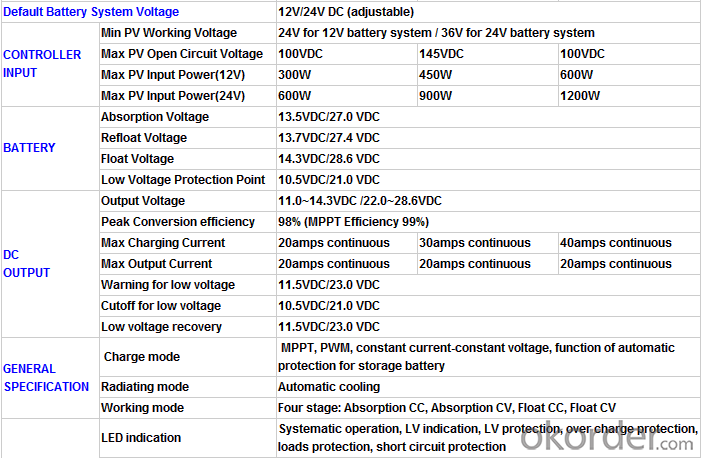
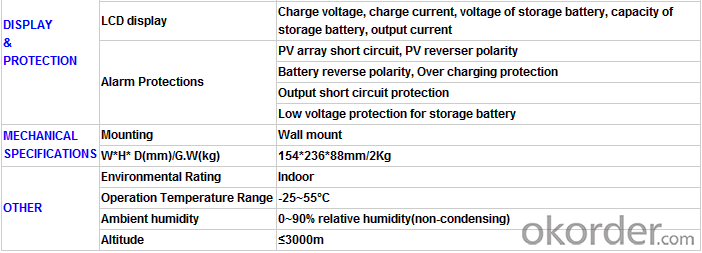
3. MPPT Solar Charger Controller Production Line:
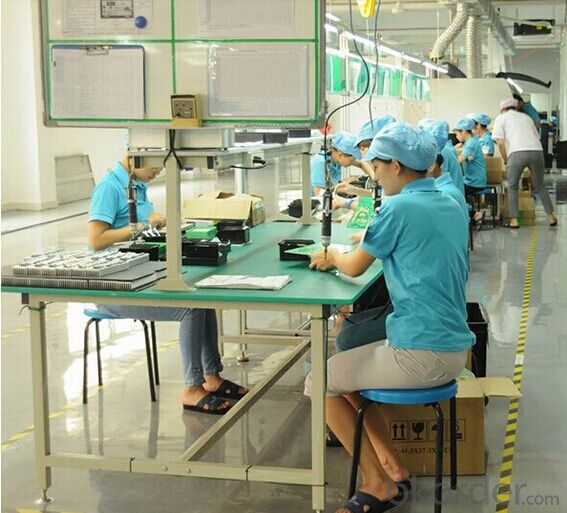
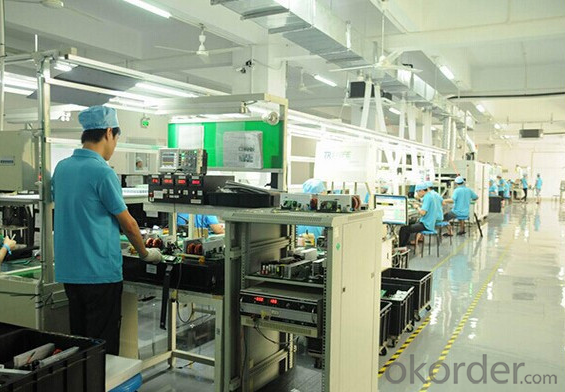
4. MPPT Solar Charge Controller Package:

5. MPPT Solar Charger Controller FAQ:
We have organized several common questions for our clients, may help you sincerely:
1. How to choose a right solar controller?
Tell us your demand, then our sales will recommend a suitable one to you.
2. What is the solar inverter warranty?
Our product warranty is valid for 12 months after delivery. We undertake to repair any malfunctioned units due to defective components of inadequate workmanship ,but specially expecting any defects resulting from normal wear and tear of improper use of the products.
3. How long can we receive the product after purchase?
a.sample orders will be delivered from our factory within 7working days .
b.General orders(under 2000pcs) will be delivered from our factory within 25 working days.
c. Bulk orders (over 2000pcs )will be delivered from our factory within 35 working days at most
4. What is the payment term?
T/T (Telegraphic transfer) / Letter of credit
- Q:Which parts are broken, how to repair
- Check the circuit, if the circuit is good, then you have to get the seller to see, because you know where is bad, you no tool material, can not change.
- Q:What is the role of a solar controller in preventing battery self-discharge?
- The prevention of battery self-discharge is of utmost importance and requires a multifaceted approach, in which the solar controller plays a vital role. The solar controller, also referred to as a charge controller or regulator, acts as a mediator between the solar panels and the battery bank in a solar power system. Its primary function is to regulate the flow of charge from the solar panels to the batteries, ensuring an efficient and effective charging process. One key method employed by a solar controller to prevent battery self-discharge is the implementation of a "low voltage disconnect" mechanism. This feature constantly monitors the battery voltage and automatically disconnects the battery from the solar panels when the voltage drops below a specific threshold. By preventing the battery from discharging beyond a safe level, the solar controller safeguards the battery against damage and extends its lifespan. Furthermore, the solar controller plays a critical role in preventing battery overcharging. Excess energy generated by the solar panels can cause the batteries to overheat and potentially fail. The solar controller addresses this issue by regulating the charging process, ensuring that the batteries receive an appropriate level of charge based on their capacity and current state of charge. Moreover, the solar controller often incorporates advanced technologies such as "pulse width modulation" (PWM) or "maximum power point tracking" (MPPT). These technologies optimize the energy transfer from the solar panels to the batteries by adjusting the voltage and current levels to match the battery's requirements. This optimization enhances charging efficiency and minimizes energy losses, effectively reducing the likelihood of battery self-discharge. In conclusion, the solar controller's role in preventing battery self-discharge encompasses the regulation of the charging process, protection against overcharging and overheating, and optimization of energy transfer. By fulfilling these functions, the solar controller ensures that the batteries remain charged, healthy, and ready for use, thereby preventing self-discharge and maximizing their performance and lifespan.
- Q:Can a solar controller be used with a solar-powered beekeeping system?
- Yes, a solar controller can be used with a solar-powered beekeeping system. A solar controller is designed to regulate and optimize the charging and discharging of batteries in a solar system. In a solar-powered beekeeping system, the solar controller would ensure that the batteries storing the solar energy are charged efficiently and that the power is distributed appropriately to power the various components of the beekeeping system, such as pumps, heaters, or lights.
- Q:Can a solar controller be used with solar panels of different angles?
- Yes, a solar controller can be used with solar panels of different angles. The solar controller's main function is to regulate the flow of electricity between the solar panels and the battery or load. It does not depend on the angle of the solar panels. However, it is worth noting that the efficiency and power output of the solar panels may vary depending on the angle at which they are installed.
- Q:Can a solar controller be used with a solar heating system?
- Yes, a solar controller can be used with a solar heating system. A solar controller helps regulate the flow of energy from the solar panels to the heating system, ensuring optimal performance and efficiency. It monitors and controls various parameters such as temperature, pressure, and flow rate, allowing for effective utilization of solar energy for heating purposes.
- Q:Can a solar controller be used with solar-powered water desalination systems?
- Yes, a solar controller can be used with solar-powered water desalination systems. A solar controller helps regulate and optimize the charging of the batteries that power the desalination system, ensuring efficient energy utilization and preventing overcharging. This allows for seamless integration of the solar panels and the desalination system, maximizing the use of renewable energy for water purification.
- Q:Can a solar controller be used with different types of solar panel snow removal systems?
- Yes, a solar controller can be used with different types of solar panel snow removal systems. The solar controller regulates the charging and discharging of the batteries in the system, and it can be configured to work with various snow removal methods such as heated wires, brushes, or automated tilting systems. The controller ensures that the snow removal system operates efficiently and effectively, regardless of the specific type of system being used.
- Q:How does a solar controller handle the switching of loads?
- A solar controller handles the switching of loads by monitoring the battery voltage and determining when it is necessary to activate or deactivate the loads. It regulates the flow of electricity from the solar panels to the battery and from the battery to the loads, ensuring the optimal use of energy and preventing overcharging or deep discharging of the battery.
- Q:Can a solar controller be used with solar-powered electric fences for livestock?
- Yes, a solar controller can be used with solar-powered electric fences for livestock. A solar controller is an essential component of a solar-powered electric fence system as it regulates the power supply from the solar panel to the fence energizer. It ensures that the battery is charged efficiently and that the fence operates effectively. The solar controller also helps in protecting the battery from overcharging and prolongs its lifespan. Therefore, using a solar controller with a solar-powered electric fence for livestock is highly recommended to ensure optimal performance and sustainability of the system.
- Q:How do I protect a solar controller from overheating?
- To protect a solar controller from overheating, there are several steps you can take: 1. Proper installation: Ensure that the solar controller is mounted in a well-ventilated area, away from direct sunlight and other sources of heat. This will help to prevent excessive heat buildup. 2. Adequate sizing: Make sure the solar controller is properly sized for your solar panel system. Undersized controllers may struggle to handle the load, leading to overheating. Consult the manufacturer's specifications or seek professional advice to ensure the controller is suitable for your system. 3. Check ambient temperature: Monitor the ambient temperature around the solar controller regularly. If the temperature rises above the recommended operating range, consider relocating the controller to a cooler area or installing additional ventilation. 4. Use heat sinks: Consider using heat sinks or heat dissipation devices, especially if the solar controller is located in a confined or enclosed space. Heat sinks help to absorb and dissipate excess heat, preventing it from building up and damaging the controller. 5. Install thermal sensors: Many advanced solar controllers come equipped with built-in thermal sensors that can detect excessive heat and automatically shut down or reduce the load on the controller. If your controller does not have this feature, you can consider installing external thermal sensors to monitor and trigger protective measures when necessary. 6. Ensure proper wiring: Faulty or loose wiring can increase resistance and cause the solar controller to overheat. Regularly inspect the wiring connections and ensure they are secure, tight, and properly insulated. If you notice any signs of damage or overheating, address the issue immediately. 7. Regular maintenance: Regularly clean and inspect the solar controller for any debris, dust, or dirt accumulation, as these can impede proper heat dissipation. Use a soft brush or compressed air to clean the controller gently. By following these steps, you can help protect your solar controller from overheating and ensure its optimal performance and longevity.
1. Manufacturer Overview |
|
|---|---|
| Location | |
| Year Established | |
| Annual Output Value | |
| Main Markets | |
| Company Certifications | |
2. Manufacturer Certificates |
|
|---|---|
| a) Certification Name | |
| Range | |
| Reference | |
| Validity Period | |
3. Manufacturer Capability |
|
|---|---|
| a)Trade Capacity | |
| Nearest Port | |
| Export Percentage | |
| No.of Employees in Trade Department | |
| Language Spoken: | |
| b)Factory Information | |
| Factory Size: | |
| No. of Production Lines | |
| Contract Manufacturing | |
| Product Price Range | |
Send your message to us
MPPT Solar Charger Controller 20A/30A/40A for Solar System
- Loading Port:
- Shekou
- Payment Terms:
- TT or LC
- Min Order Qty:
- 50 pc
- Supply Capability:
- 100000 pc/month
OKorder Service Pledge
OKorder Financial Service
Similar products
New products
Hot products
Hot Searches
Related keywords
